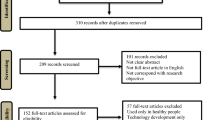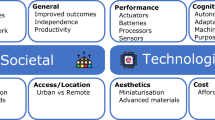Abstract
The aim of the paper is to address an innovative methodology for assessing the usability of a product. This methodology is particularly suitable for designing products that provide their main functions through their control interfaces. In particular, this case study relates to the usability assessment of two control devices for a wheelchair-mounted robot manipulator to assist physically disabled people. The study focuses on defining a synthetic usability index on the basis of two currently used methods: the multi criteria decision analysis and the Saaty’s analytic hierarchy process. Several virtual reality (VR)-based experiments have been conducted, set up in accordance with a cross-array experimental plan, that adequately caters for both control and noise factors. Quantitative measures and subjective user evaluations have been collected to maximize the effectiveness, the efficiency and the satisfaction perceived by users while using the product. Compared to the literature on the subject, the proposed approach provides both more flexibility in defining quantitative indexes and more adequate results, even when involving only a small sample of users in the participatory design session. The use of VR technologies for the collection of the experimental data has been essential in terms of safety, costs and repeatability of the tests, as well as of the robustness with respect to noise factors.













Similar content being viewed by others
Notes
It is understood that those devices actually control the computer-generated viewpoint only, without affecting the physical position of the wheelchair in the laboratory.
References
Abbattista F, Degemmis M, Licchelli O, Lops P, Semeraro G, Zambetta F (2002) Improving the usability of an e-commerce web site through personalization. In: Ricci F, Smith B (eds) Recommendation and personalization in Ecommerce, 2nd International conference on adaptive hypermedia and adaptive web based systems, pp 20–29
Bevan N (2009) Extending quality in use to provide a framework for usability measurement. In: HCD 09: proceedings of the 1st international conference on human centered design. Springer, Berlin, pp 13–22
Caputo F, Di Gironimo G (2007) Vrtest: a virtual reality sysTEm for tranSporTation design. Centre of Competence for Transport Systems of the Campania Region, An experience of innovation and training
Caputo F, Di Gironimo G, Papa S (2006) A virtual reality system for ergonomics and usability validation of equipment controls. Anales de Ingenierìa Gràfica 18:47–64
Das H, Zak H, Johnson J, Crouch J, Frambach D (1999) Evaluation of a telerobotic system to assist surgeons in microsurgery. Comput Aided Surg 15–25
Davies R (2004) Adapting virtual reality for the participatory design of work environments. Comput. Supported Coop. Work 13(1):1–33. doi:10.1023/B:COSU.0000014985.12045.9c
De Santis A, Di Gironimo G, Marzano A, Siciliano B, Tarallo A (2008) A virtual-reality-based evaluation environment for wheelchair-mounted manipulators. In: Proceedings of the 6th EUROGRAPHICS Italian Chapter 2008 conference. Salerno, Italy, pp 1–8
Di Gironimo G, Lanzotti A (2009) Designing in VR. Int J Interact Design Manuf (IJIDeM) 3(2):51–53
Di Gironimo G, Marzano A, Tarallo A (2007) Human robot interaction in virtual reality. In: 5th EUROGRAPHICS Italian chapter conference. Trento, Italy, pp 1–8
Di Gironimo G, Patalano S, Tarallo A (2009) Innovative assembly process for modular train and feasibility analysis in virtual environment. Int J Interact Design Manuf (IJIDeM) 3(2):93–101
Dinh HQ, Walker N, Song C, Kobayashi A, Hodges LF (1999) Evaluating the importance of multi-sensory input on memory and the sense of presence in virtual environments. Virtual Reality Conference, IEEE 0, 222. doi:10.1109/VR.1999.756955
Eftring H, Boschian K (1999) Technical results from manus user trials. In: Proceedings of the international conference on rehabilitation robotics (ICORR). Stanford, CA, pp 136–141
Eraslan E, Akay D, Kurt M (2006) Usability ranking of intercity bus passenger seats using fuzzy axiomatic design theory. In: CDVE, pp 141–148
Eriksson J, Johansson G (1996) Adaptation of workplaces and homes for disabled people using computer aided design. Int J Ind Ergonomics 17(2):153–162. doi:1016/0169-8141(95)00046-1
Figueira J, Greco S, Ehrgott M (2005) Multiple criteria decision analysis: state of the art surveys. Springer, Berlin
Frøkjær E, Hertzum M, Hornbæk K (2000) Measuring usability: are effectiveness, efficiency, and satisfaction really correlated? In: CHI’00: proceedings of the SIGCHI conference on Human factors in computing systems. ACM, New York, pp 345–352. doi:10.1145/332040.332455
Ghosh R, Dekhil M (2009) Discovering user profiles. In: Proceedings of the 18th international conference on World wide web, WWW’09. ACM, New York, pp 1233–1234. doi:10.1145/1526709.1526944
Hassenzahl M (2003) The thing and i: understanding the relationship between user and product. In: Blythe MA, Overbeeke K, Monk AF (eds) Funology: from usability to enjoyment (human–computer interaction series). Kluwer Academic Publishers, Norwell, pp 31–42
Hillman M, Gammie A (1994) The bath institute of medical engineering assistive robot. In: Proceedings of ICORR 94. Wilmington, pp 211–212
Hornbaek K (2006) Current practice in measuring usability: Challenges to usability studies and research. Int J Hum Comput Stud 64(2):79–102. doi:10.1016/j.ijhcs.2005.06.002
ISO/IEC standard (1998) Ergonomic requirements for office work with visual display terminals—guidance on usability. ISO 9241-11:1998
Jaspers M (2009) A comparison of usability methods for testing interactive health technologies: Methodological aspects and empirical evidence. I. J Med Inf 78(5):340–353
Jolliffe I (2002) Principal component analysis. Springer Verlag, Secaucus
Kalawsky R (1998) New methodologies and techniques for evaluating user performance in advanced 3d virtual interfaces. IEE Digest. 1998(437), 5/1–5/8. doi:10.1049/ic:19980654
Kanai S, Horiuchi S, Kikuta Y, Yokoyama A, Shiroma Y (2007) An integrated environment for testing and assessing the usability of information appliances using digital and physical mock-ups. Springer, Berlin. doi:10.1007/978-3-540-73335-5
Kilic Delice E, Güngör Z (2009) The usability analysis with heuristic evaluation and analytic hierarchy process. Int J Ind Ergonomics 39(6):934–939. doi:10.1016/j.ergon.2009.08.005
Kim J, Han S (2008) A methodology for developing a usability index of consumer electronic products. Int J Ind Ergonomics 38(3–4):333–345. doi:10.1016/j.ergon.2007.12.002
Kuutti K, Battarbee K, Säde S, Mattelmäki T, Keinonen T, Teirikko T, Tornberg A (2001) Virtual prototypes in usability testing. In: HICSS’01: proceedings of the 34th annual Hawaii international conference on system sciences (HICSS-34), vol 5, p 5029. IEEE Computer Society, Washington
Lanzotti A, Matrone G, Tarantino P, Vanacore A (2008) Statistical design for innovation in VR. In: Erto P (eds) Statistics for innovation. Springer, Milan, pp 27–41
Liljegren E (2004) Cognitive engineering methods as usability evaluation tools for medical equipment. Int J Ind Ergonomics 34(1):49–62. doi:10.1016/j.ergon.2004.01.008
Lin M, Wang C, Chen M, Chang C (2008) Using ahp and topsis approaches in customer-driven product design process. Comput Ind 59(1):17–31. doi:10.1016/j.compind.2007.05.013
Mahdjoub M, Monticolo D, Gomes S, Sagot J (2009) A collaborative design for usability approach supported by virtual reality a multi-agent system embedded in a plm environment. Computer-Aided Design. doi:10.1016/j.cad.2009.02.009
Montero F, Lozano M, Gonzalez P (2008) Usability-oriented quality model based on ergonomic criteria. Handbook of research on web information systems quality
Muzzupappa M, Bruno F, Mattanò RM, Pina M (2006) A new approach to participatory design: usability tests in virtual environment. In: Research in interactive design, vol 1, Cap. X. SpringerVerlag., New York, pp 80–90
Nagarajan U, Kantor G, Hollis RL (2009) Human–robot physical interaction with dynamically stable mobile robots. In: Proceedings of the 4th ACM/IEEE international conference on human robot interaction, HRI’09. ACM, New York, pp 281–282. doi:10.1145/1514095.1514176
Nielsen J (1993) Usability engineering. Morgan Kaufmann Publishers Inc., San Francisco
Norman D (2004) Emotional design. Perseus Publishing, New York
Park S (1996) Robust design and analysis for quality engineering. Kluwer Academic Publishers, London
Petrie H, Hamilton F, King N, Pavan P (2006) Remote usability evaluations with disabled people. In: CHI’06: proceedings of the SIGCHI conference on human factors in computing systems, pp 1133–1141. ACM, New York. doi:10.1145/1124772.1124942
Pithon T, Weiss T, Richir S, Klinger E (2009) Wheelchair simulators: a review. Technol Disabil 21(1):1–s10
Saaty L (2008) Decision making with the analytic hierarchy process. Int J Services Sci 1(1):83–98. doi:10.1504/IJSSCI.2008.017590
Sauer J, Seibel K, Rüttinger B (2009) The influence of user expertise and prototype fidelity in usability tests. Appl Ergonomics. doi:10.1016/j.apergo.2009.06.003
Sauro J, Kindlund E (2005) A method to standardize usability metrics into a single score. In: CHI’05: proceedings of the SIGCHI conference on human factors in computing systems. ACM, New York, pp 401–409. doi:10.1145/1054972.1055028
Shackel B, Richardson S (2008) Human factors for informatics usability. Cambridge University Press, New York
Sharma V, Simpson R, LoPresti E, Mostowy C, Olson J, Puhlman J, Hayashi S, Cooper R, Konarski E, Kerley B (2008) Participatory design in the development of the wheelchair convoy system. J NeuroEng Rehabil 5(1):1 (2008). doi:10.1186/1743-0003-5-1. http://www.jneuroengrehab.com/content/5/1/1
Tullis T, Albert B (2008) Measuring the user experience. Morgan Kauffmann Publishers, San Francisco
Wallergard M, Eriksson J, Johansson G (2008) A suggested virtual reality methodology allowing people with cognitive disabilities to communicate their knowledge and experiences of public transport systems. Technol Disabil 20(1):9–24
Acknowledgments
The present work was developed with the contribution of the Italian Ministry of Education, University and Research (MIUR) within the framework of the PRIN 2008 project called “Innovation in service quality management: statistical approach and application in some fields of national interest”. The authors also thank “Polo ST UniNa” that has partially funded the work within the framework of “Faro Project”. Finally, the authors would like to thank Agostino De Santis for his interesting discussions about assistive robotics and Human–Robot Interaction and Amedeo Sgura for his helpful research work during his master degree thesis and the anonymous referees for their suggestions. We would also like to mention Neatech s.r.l. for having provided the physical wheelchair with the corresponding CAD model used for VR experiments.
Author information
Authors and Affiliations
Corresponding author
Rights and permissions
About this article
Cite this article
Di Gironimo, G., Matrone, G., Tarallo, A. et al. A virtual reality approach for usability assessment: case study on a wheelchair-mounted robot manipulator. Engineering with Computers 29, 359–373 (2013). https://doi.org/10.1007/s00366-012-0274-x
Received:
Accepted:
Published:
Issue Date:
DOI: https://doi.org/10.1007/s00366-012-0274-x




